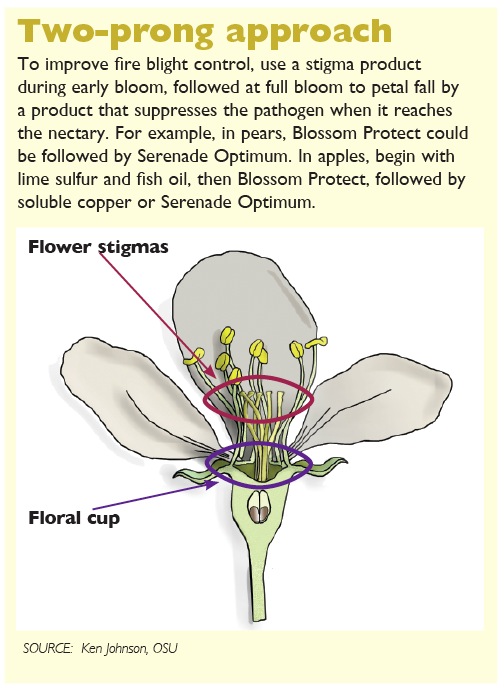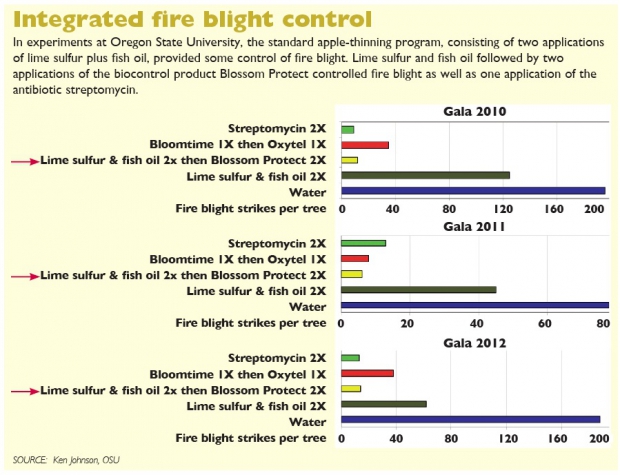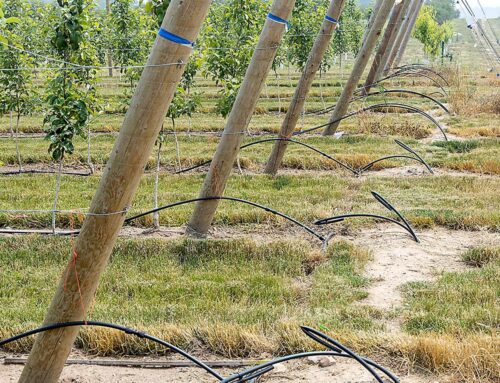
Fire blight control. (Source: Ken Johnson/ Oregon State University)
Organic apple and pear growers are being urged to test new strategies for controlling fire blight this season, as this is the last time they’ll be able to use antibiotics as a fallback option.
Organic growers have been allowed to use antibiotics in the past, but the National Organic Standards Board has voted to remove the antibiotics oxytetracycline and streptomycin from the allowed list of synthetic materials, effective this fall.
Scientists in Washington, Oregon, and California have been working to develop alternatives for organic growers with funding from a U.S. Department of Agriculture grant.
Fire blight is a serious bacterial disease that can kill trees and spread rapidly through entire orchards.
Fire blight infections begin in blossoms when large numbers of cells of the pathogen Erwinia amylovora build up on the stigmas and are washed down by rain or dew into the floral cups, where they enter the developing fruitlets via the openings from which nectar is secreted.
Because heat affects how quickly the pathogen builds up on stigmas, temperature-based models, such as CougarBlight, are used to assess the risk of infection.
Antibiotics are powerful enough to control the pathogen when a model indicates that it has built up to high numbers on the stigmas. However, some biological controls will need to be applied before the risk of infection is known because they work by colonizing flowers and preventing fire blight bacteria from building up.
For example, the yeast Blossom Protect (Aureobasidium pullulans) will need to be sprayed at least once between 80 percent to full bloom regardless of what the model says, according to Dr. Ken Johnson, plant pathologist with Oregon State University.
Johnson has been developing an integrated nonantibiotic control strategy using materials that stop the fire blight pathogen from growing on the stigma followed by those that suppress the pathogen when it reaches the nectary.
Lime sulfur
Johnson believes that apple growers will find it less difficult than pear growers to control the disease without antibiotics because apples are less susceptible than pears and because many apple growers use lime sulfur to thin their crop during bloom.
Lime sulfur is toxic to the fire blight pathogen and also lessens the potential for infection by reducing the number of flowers.
Apple growers using biological materials to control fire blight should apply them after lime sulfur sprays, as sulfur is also toxic to biocontrol agents. Johnson reports that, in tests, lime sulfur applied at 20 percent and 70 percent bloom, followed by two Blossom Protect treatments at 80 percent and full bloom, provided as good control as streptomycin.
An organically approved soluble copper or the fungicide/bactericide Serenade Optimum can then be applied to target the pathogen in the floral cup.
Blossom Protect grows well on flower stigmas and is spread from flower to flower by insects and so can provide protection over a period of time. In Europe, multiple applications of the yeast have caused russetting on fruit, though this has not been seen in the drier fruit-producing regions.
Serenade Optimum, which is produced by fermenting a strain of Bacillus subtilis, has a different mode of action from Bloomtime or Blossom Protect. Its antimicrobial activity comes mostly from biochemical compounds produced by the bacterium during fermentation, not from colonizing flowers.
When applied after Blossom Protect, Serenade Optimum could not only target the fire blight pathogen, but prevent yeast levels from increasing too much and causing russet. In tests, flowers and fruit sprayed with Serenade Optimum showed very little russetting.
An integrated program for pear growers would be Blossom Protect followed by Serenade Optimum, Johnson suggests.
Copper
Growers often use fixed copper products during the dormant or delayed-dormant (green-tip) period to kill bacteria oozing from fire blight cankers. Johnson said studies show that a copper treatment can slow the build-up of the fire blight pathogen in the flowers and should be considered as part of a nonantibiotic strategy.
Copper materials are generally phytotoxic when used later, but new soluble coppers are becoming available that contain much less metallic copper and can be used during and after bloom.
Cueva copper soap, which contains 1.8 percent metallic copper, is registered for use, and Previsto, a copper ammonium complex containing 3.2 percent metallic copper, is expected to be registered next year.
As there might still be some risk of fruit russetting in certain conditions, more tests are needed to assess their potential role in controlling fire blight, Johnson said.

Fire blight control. (Source: Ken Johnson/ Oregon State University)
More Information
This article is based on a more in-depth paper by Johnson.
Another publication on integrating the new research into a systems approach is available from WSU’s sustainable agriculture specialist David Granatstein, who can be contacted at granats@wsu.edu.
The document will soon be posted on The Organic Center Web site.
More information on fire blight control in organic tree fruits.
For more background information, watch two, hour-long webinars at youtube.com/watch?v=59_-51AT2Fk and youtube.com/watch?v=NuKxKCWKl28. •






Leave A Comment